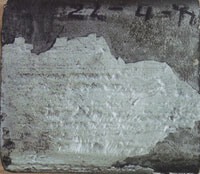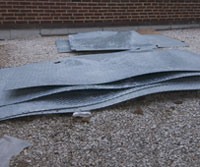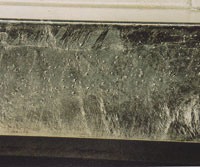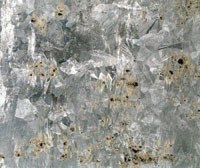D-E
Delamination

Delamination or peeling creates a rough coating on the steel where the zinc has peeled off. There are a number of causes for zinc peeling. Many large galvanized parts take a long time to cool in the air and form zinc-iron layers after they have been removed from the galvanizing kettle. This continued coating formation leaves behind a void between the top two layers of the galvanized coating. If there are many voids formed, the top layer of zinc can separate from the rest of the coating and peel off the part. If the remaining coating still meets the minimum specification requirements, then the part is still acceptable. If the coating does not meet the minimum specification requirements, then the part must be rejected and regalvanized. If delamination (Figure 29) occurs as a result of fabrication after galvanizing, such as blasting before painting, then the galvanizer is not responsible for the defect.
Distortion

Distortion (Figure 30) is the buckling of a thin, flat steel plate or other flat material such as wire mesh. Distortion is caused by differential thermal expansion and contraction rates for thinner pieces attached to thicker, surrounding steel. Because the thinner piece is welded, it cannot move and this creates a high stress level often relieved by distortion of the part. Best practice to avoid distortion is to fabricate parts with similar thicknesses where possible or use a thicker plate, ribs, or corrugations to stiffen flat sections. For more on minimizing distortion, please see the AGA's publication The Design of Products to be Hot-Dip Galvanized after Fabrication. Distortion is acceptable, unless it prevents the part from fulfilling its intended use. Many distorted thin steel sheets can be bent after galvanizing to bring the part to an acceptable final condition.
Drainage Spikes

Drainage spikes or drips are tear drops of zinc along the edges of the product. Spikes and drips are caused when steel products are removed from the galvanizing kettle horizontally preventing proper drainage of the zinc from the surface (Figure 31). Drainage spikes are typically removed during the inspection stage by a buffing or grinding process. Drainage spikes or drips are excess zinc and will not affect corrosion protection, but are potentially dangerous for anyone who handles the parts. Therefore, they must be removed before the part can be accepted.
Dross Inclusions

Dross inclusions are a distinct particle of zinc-iron intermetallic alloy that becomes entrapped or entrained in the zinc coating (Figure 32). This is caused by picking up zinc-iron particles from the bottom of the kettle, and may be avoided by changing the lifting orientation or redesigning the product to allow for more effective drainage. If the dross particles are small and completely covered by zinc metal, they will not affect the corrosion protection and are acceptable. If there are gross dross particles (large inclusions, then the particles must be removed and the area repaired.
Excess Aluminum in Galvanizing Bath

Another type of surface defect is caused by an excess amount of aluminum in the galvanizing bath (Figure 33). Galvanizers are required to have a bath of 98% pure zinc, according to the product specifications ASTM A123, A153, and A767, while the remaining 2% may include additives at the galvanizer's discretion. One common additive is aluminum, which helps with the aesthetic of the coating. When excess aluminum is in the galvanizing bath, it creates black marks or bare spots on the surface of the steel. This can be avoided by ensuring proper control of the aluminum level in the galvanizing bath by means of regular sampling and analysis, and by adjusting the levels in a regular and controlled manner. Bare spots due to excess aluminum in the bath may be repaired if only small areas are evident; however, if this condition occurs over the entire part, it must be rejected, stripped, and regalvanized.